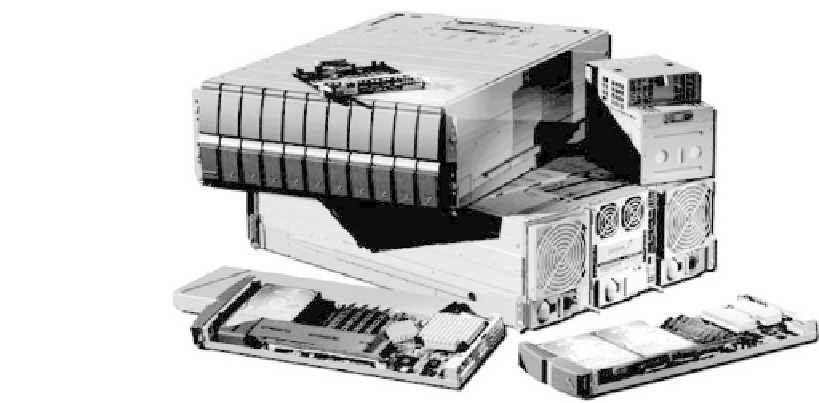Database Reference
In-Depth Information
Integrated GE Switch
Battery Module
(2 Power Units)
1 DirectorBlade,
10 StorageBlades
(Shelf Front)
Shelf Rear
Figure 2.3
(See color insert following page 224.) Panasas storage clus-
ters are built of bladeserver shelves containing object-serving StorageBlades;
metadata-managing DirectorBlades; batteries; and redundant power, cooling,
and networking.
called StorageBlades, or metadata managers, called DirectorBlades. All slots
share redundant gigabit or 10 gigabit Ethernet networking, redundant cooling,
redundant power supplies, and an integrated uninterruptable power supply
(UPS) large enough to cleanly shut down all blades on power failure. Storage-
Blades contain two large-capacity commodity disk drives and an embedded
controller with a variable amount of cache memory and implement an object
storage protocol,
5
,
8
standardized as the SCSI Object Storage Device (OSD)
protocol,
40
transported over IP-based Ethernet using the iSCSI storage area
network. DirectorBlades contain a small local disk for code and journals and a
server-class processor and memory, and implement network file system (NFS)
and common Internet file system (CIFS) protocol servers to access Panasas
storage from legacy non-Linux clients as well as the PanFS parallel file sys-
tem metadata manager. When additional shelves are powered up in the same
domain as an existing Panasas system, the new blades are recognized and
incorporated into the existing system; and, under administrator control, the
existing storage data can be transparently rebalanced over the existing and
new blades.
Panasas storage was designed to be accessed in parallel from each client
in one or more Linux compute clusters, as illustrated in Figure 2.4. Files are
striped over objects stored on different storage blades so that a client can
increase performance by accessing multiple objects at the same time in paral-
lel, and multiple clients can be accessing the same or different files in parallel
at the same time, up to the bandwidth limitations of the network between








